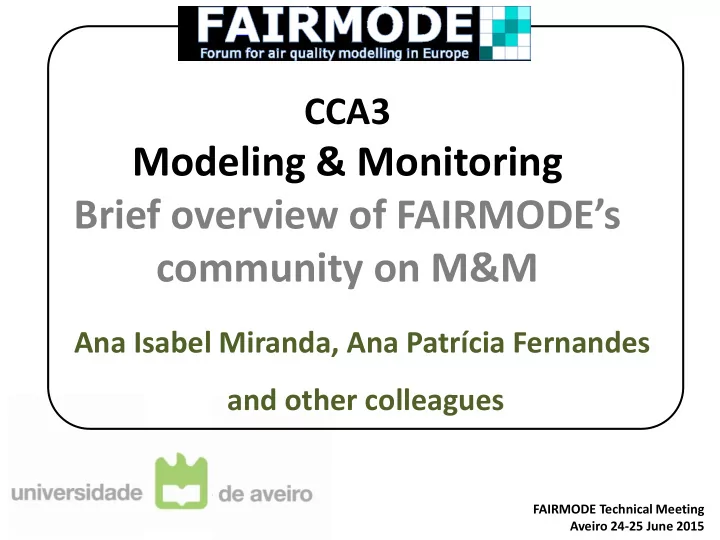

CCA3 Modeling & Monitoring Brief overview of FAIRMODE’s community on M&M Ana Isabel Miranda, Ana Patrícia Fernandes and other colleagues FAIRMODE Technical Meeting Aveiro 24-25 June 2015
‘ combination of modelling and monitoring’ - any method that makes use of both models and monitoring to provide improved information on air quality. Source: Bruce and Spangl, 2010 WG2 FAIRMODE
W ORK PLAN IDEAS 2015 1. REVIEWING METHODOLOGIES • Comparison of various methodologies (for assessment and planning ) in which monitoring and modeling data are used in conjunction. 2. GUIDANCE ON MODEL VALIDATION WHEN USING M&M • Guidance on model validation after combination of monitoring/modelling and its incorporation into the model quality objectives and model evaluation tool.
Contribution to WG1 Guidance document - update the review document produced during the previous FAIRMODE phase - include the testing of Claudio’s proposal It’s today! Next technical meeting
17 replies from 12 countries: Very simple questions - 1 Sweden Q1 Do you apply combined modelling and monitoring data techniques? - 2 Belgium - 3 Germany Q2 What are these techniques? - 1 UK - 1 France Q3 In which scope did you apply these techniques - 2 Italy (research, forecasting, long-term planning, - 1 Netherlands management …)? - 1 Austria - 1 Denmark Q4 Can you provide a publication about these - 1 Czech Republic activities? - 2 Spain - 1 Portugal
Technique Purpose Comments intelligent interpolation forecasting, assessment, land use function and planning measurements – RIO (BE) background values annual assessment, local scale (AT, DK, UK) planning, research krigging re-analysis (NL) operational forecast, local external drift krigging (FR) management, re-analysis, research linear regression and assessment, research urban and rural stations kriging interpolation separately (SP) (CZ) optimal interpolation operational forecasting (AT) research (BE) planning (IT) management (DE) support vector regression maps for model satellite data (AT) (machine) initialization forecasting local measurements (SE) research
Technique Purpose Comments successive correction research, management (IT) method kalman filter forecasting and ensemble (NL) (FR) assessment re-analysis bias correction at stations at surface (SP, PT) AURORA (BE) variational analysis operational assessment using background stations (SE) data assimilation research, operational 3- and 4d-var data forecasting, management assimilation (DE, AT, SP, IT)
Fractional bias (hourly data) between PM10 measurements at Austrian AQ stations and model results (february 2010) (Hirtl et al., 2014) The Support Vector Regression technique was applied to derive highly- resolved PM10 initial fields for air quality modeling from satellite measurements of the Aerosol Optical Thickness. Additionally, PM10-ground measurements were assimilated using optimum interpolation. No measurements data included Ground stations and satellite data assimilated
Methodology for measurements and modelling combination (Martin et al., 2012) The use of this methodology has improved the results obtained when using only the (CHIMERE) model data.
How to validate when using a combination of monitored and modelled data?
How to validate? Leave one out Group approach “ integration ” The is A set of n 1 <n stations is performed times and selected for the validation n each time one of the and the others n-n 1 are used for the “ integration ” . stations is used to test the results and the others n-1 stations are used for the “ integration ” More robuts, but how to select the stations? Large number of re-analyses, but “ simple ”
How to validate? based on a Monte Carlo approach 1. A set of n Monte Carlo re-analyses has to be done a) For each one randomly select 20% of the stations to be used as validation stations (do not use them to perform the re-analysis) b) Compute for each station i (at least) in each re-analysis j the RMSE (i,j) 2. Compute for each station i the maximun of RMSE (i,j). Let be vect_max(i) the number of the re-analysis associated to the maximum RMSE for station i 3. Create a CDF file to be used in the DELTAtool by selecting for each station i the vect_max (i) 4. Use the Deltatool as if the CDF file was the CDF of a single model
Who wants to test this approach? UNIBS UAVR INERIS VITO It’s today! To present results and conclusion at the next technical meeting
… and - Statistical post-processing technique – S Anderson, SMHI - Validation of complex data assimilation methods. The EURAD example – H Elbern, RIU - ETC/ACM mapping methods – J Horalek, CMHI - Metholody to detect outliers in the Airbase database – O Kracht, JRC
W ORK PLAN IDEAS 2015 1. REVIEWING METHODOLOGIES • Comparison of various methodologies (for assessment and planning ) in which monitoring and modeling data are used in conjunction. 2. GUIDANCE ON MODEL VALIDATION WHEN USING M&M • Guidance on model validation after combination of monitoring/modelling and its incorporation into the model quality objectives and model evaluation tool. How to validate model outputs after combination of M&M? How to arrive to an independent model evaluation? How can this be incorporated into the model quality objectives and model evaluation tool?
Univ niversid idade de Aveir iro Thank you for your attention www.dao.ua.pt/gemac miranda@ua.pt
Recommend
More recommend